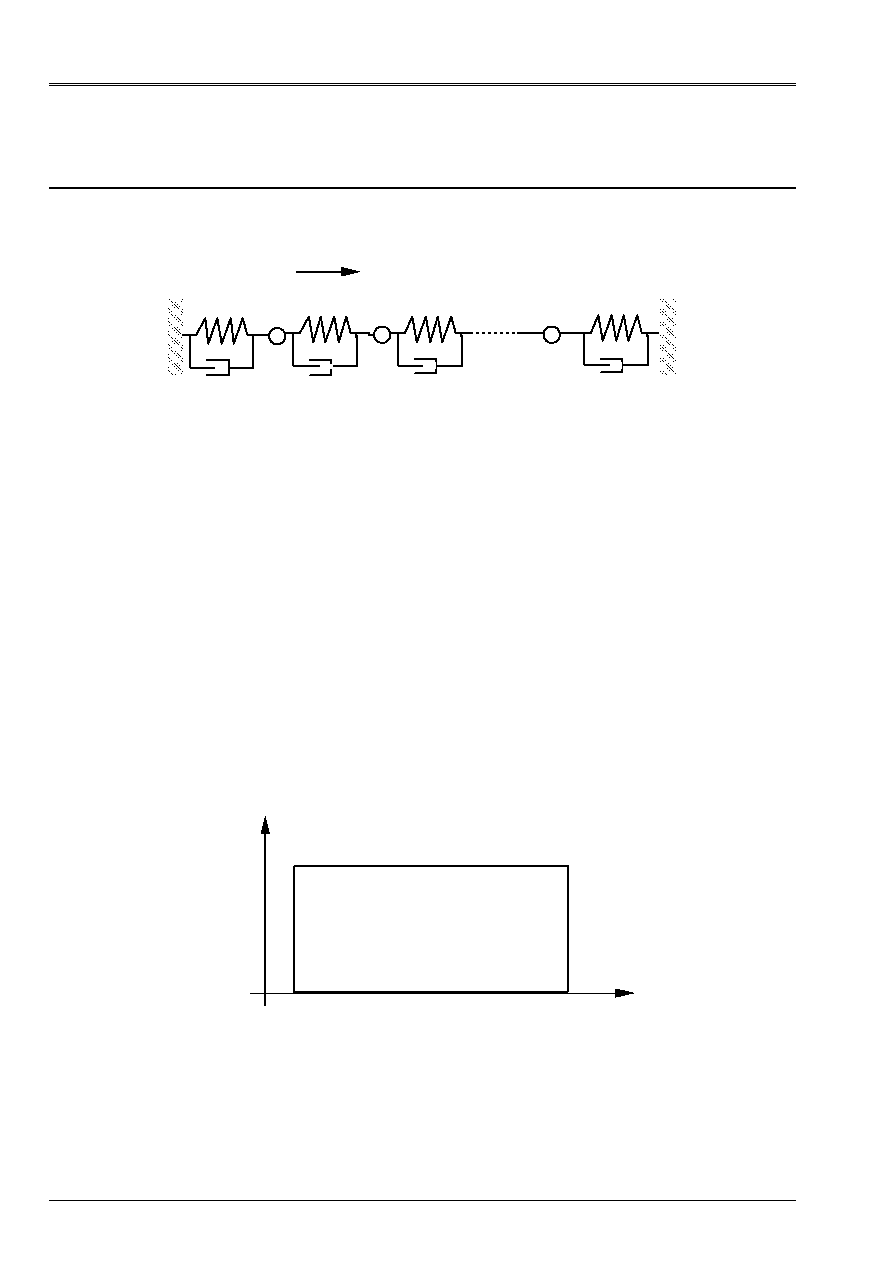
Code_Aster
®
Version
5.0
Titrate:
SDLD23 System of masses and springs under random excitation
Date:
30/08/01
Author (S):
J. PIGAT
Key:
V2.01.023-B
Page:
1/6
Manual of Validation
V2.01 booklet: Linear dynamics of the discrete systems
HT-62/01/012/A
Organization (S):
EDF/RNE/AMV
Manual of Validation
V2.01 booklet: Linear dynamics of the discrete systems
V2.01.023 document
SDLD23 - System of masses and springs
under random excitation
Summary:
This test is in the course of validation within the framework of the VPCS.
It comprises a whole of eight specific masses and nine springs excited by an imposed random force
on one of the masses.
The excitation is of white Gaussian noise type. It is given by the spectral concentration of power of the exiting force.
The movement of the excited mass is calculated by a stochastic approach according to different
frequential discretizations for the answer.
One also calculates in postprocessing the spectral moments of the answer.

Code_Aster
®
Version
5.0
Titrate:
SDLD23 System of masses and springs under random excitation
Date:
30/08/01
Author (S):
J. PIGAT
Key:
V2.01.023-B
Page:
2/6
Manual of Validation
V2.01 booklet: Linear dynamics of the discrete systems
HT-62/01/012/A
1
Problem of reference
1.1 Geometry
P1
C
m
C
K
K
m
P2
C
K
C
K
P8
dx
The excitation is a seismic movement of type forces imposed applied to the P4 point in the direction dx.
One is interested in the DSP of displacement of the P4 node.
1.2
Material properties
Specific masses:
m = 10 kg
Elastic springs:
K = 10
5
NR/m
Shock absorbers:
C = 50 NR/(m/s)
1.3
Boundary conditions and loadings
The problem is unidimensional in direction X (1 ddl by mass).
The excitation is a DSP of constant force of level 1, between 3 and 13 Hz.
13
3
Frequency (Hz)
1
DSP
(N2/Hz)

Code_Aster
®
Version
5.0
Titrate:
SDLD23 System of masses and springs under random excitation
Date:
30/08/01
Author (S):
J. PIGAT
Key:
V2.01.023-B
Page:
3/6
Manual of Validation
V2.01 booklet: Linear dynamics of the discrete systems
HT-62/01/012/A
2
Reference solution
2.1
Method of calculation used for the reference solution
The solution taken for reference results from test SDLD23 of guide VPCS [bib1].
2.2
Results of reference
Peak of the response to the first Eigen frequency.
Values of the first spectral moments for various discretizations.
2.3 Reference
Guide VPCS.

Code_Aster
®
Version
5.0
Titrate:
SDLD23 System of masses and springs under random excitation
Date:
30/08/01
Author (S):
J. PIGAT
Key:
V2.01.023-B
Page:
4/6
Manual of Validation
V2.01 booklet: Linear dynamics of the discrete systems
HT-62/01/012/A
3 Modeling
With
3.1
Characteristics of modeling
Discrete element in translation of the type
DIS_T
Modeling respects the geometry.
Characteristics of the elements:
With the P1 nodes in P8: matrices of masses of the type
M_T_D_N
with m = 10 kg.
Elements of spring: a matrix of stiffness of the type
K_T_D_L
with K
X
= 10
5
NR/m
Elements of damping: a matrix of damping of the type
A_T_D_L
with C
X
= 50 NR/m
Boundary conditions:
All the DDL are locked except the DDL dx.
Modal damping is calculated by the operator of modal calculation, it is reinjected like
modal damping in random dynamic calculation.
3.2
Characteristics of the mesh
A number of nodes: 10
A number of meshs and types: 9 SEG2, 10 POI1
3.3 Functionalities
tested
Controls
DEFI_INTE_SPEC PAR_FONCTION
DYNA_ALEA_MODAL BASE_MODALE AMOR
EXCIT
SIZE
“EFFO”
ANSWER
REST_SPEC_PHYS
POST_DYNA_ALEA MOMENT

Code_Aster
®
Version
5.0
Titrate:
SDLD23 System of masses and springs under random excitation
Date:
30/08/01
Author (S):
J. PIGAT
Key:
V2.01.023-B
Page:
5/6
Manual of Validation
V2.01 booklet: Linear dynamics of the discrete systems
HT-62/01/012/A
4
Results of modeling A
4.1 Values
tested
DSP of displacement to the P4 node
Identification Reference Aster %
Difference
ABSOLUTE: F = 5.5259 Hz
0.1059E5
0.1059E5
0%
Spectral moments for the discretization by defect (50 points per peak)
Identification Reference Aster %
Difference
Spectral moment n°0
1.585 10
7
1.618
10
7
2.11%
Spectral moment n°2
1.902 10
4
1.942
10
4
2.12%
Spectral moment n°4
2.322 10
1
2.370
10
1
2.09%
Spectral moment n°6
2.941 10
2
3.001
10
2
2.05%
Spectral moment n°8
4.143 10
5
4.226
10
5
2.00%
Spectral moments for the discretization with regular pitch 0.25 Hz (40 pitches)
Identification Reference Aster %
Difference
Spectral moment n°0
1.585 10
7
2.339
10
7
47.61%
Spectral moment n°2
1.902 10
4
2.790
10
4
46.73%
Spectral moment n°4
2.322 10
1
3.368
10
1
45.05%
Spectral moment n°6
2.941 10
2
4.173
10
2
41.91%
Spectral moment n°8
4.143 10
5
5.600
10
5
35.17%
Spectral moments for the discretization with regular pitch 0.05 Hz (200 pitches)
Identification Reference Aster %
Difference
Spectral moment n°0
1.585 10
7
1.577
10
7
0.44%
Spectral moment n°2
1.902 10
4
1.893
10
4
0.46%
Spectral moment n°4
2.322 10
1
2.311
10
1
0.48%
Spectral moment n°6
2.941 10
2
2.928
10
2
0.43%
Spectral moment n°8
4.143 10
5
4.130
10
5
0.30%
Spectral moments for the discretization with regular pitch 0.025 Hz (400 pitches)
Identification Reference Aster %
Difference
Spectral moment n°0
1.585 10
7
1.585
10
7
0.02%
Spectral moment n°2
1.902 10
4
1.902
10
4
0.01%
Spectral moment n°4
2.322 10
1
2.322
10
1
0.02%
Spectral moment n°6
2.941 10
2
2.941
10
2
0.00%
Spectral moment n°8
4.143 10
5
4.144
10
5
0.03%
4.2 Parameters
of execution
Version: 5.02
Machine: SGI ORIGIN 2000
System:
Overall dimension memory: 8 megawords,
time CPU To use:
3.60 seconds

Code_Aster
®
Version
5.0
Titrate:
SDLD23 System of masses and springs under random excitation
Date:
30/08/01
Author (S):
J. PIGAT
Key:
V2.01.023-B
Page:
6/6
Manual of Validation
V2.01 booklet: Linear dynamics of the discrete systems
HT-62/01/012/A
5
Summary of the results
The preceding tables highlight the importance of the smoothness of the discretization
frequential of the DSP response for the calculation of the spectral moments.
The user can choose the pitch: the frequency band is then discretized in a uniform way and it or
the peaks can be badly represented: it is the case with 40 pitches of 0.25 Hz, which involves an error
of more than 40% at the spectral time.
More one refines the discretization, better is the result.
To avoid refining unnecessarily far from the peaks, one proposes a discretization by rather broad defect
supplemented by a refinement of 50 points of discretization around each peak.
In the case of this test which includes/understands one peak, this discretization by defect makes it possible to estimate
spectral moments with a precision of about 2%.





